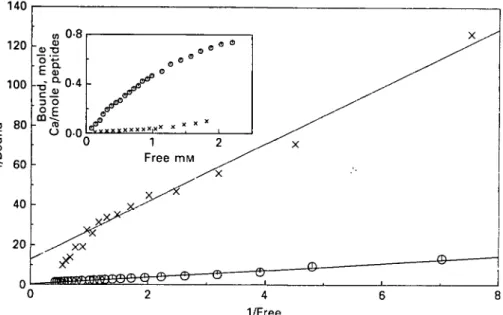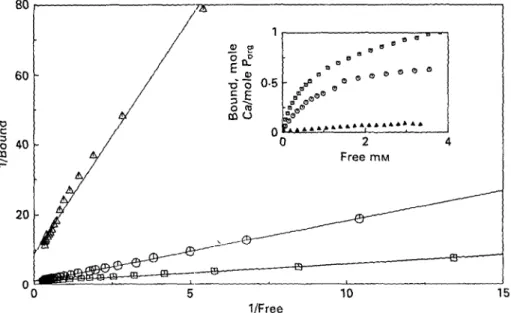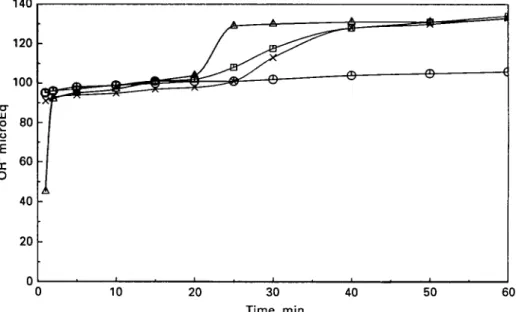Tryptic phosphopeptides from whole casein. II. Physicochemical
properties related to the solubilization of calcium
BY RAFAEL BERROCAL, SERGE CHANTON, MARCEL A. JUILLERAT, BLAISE PAVILLARD, JEAN-CLAUDE SCHERZ AND ROLF JOST Nestle Research Centre, Nestec Ltd, Vers-chez-les-Blanc, CH-1000 Lausanne 26,
Switzerland
SUMMARY. Casein phosphopeptides (CPP) were produced by tryptic hydrolysis of sodium caseinate and further purified by precipitation and chromatography on QAE-Sephadex A-25. Their physico-chemical properties were compared with the properties of an enzymically dephosphorylated equivalent preparation (DPP).
Binding of Ca2+ to the peptides was measured using a Ca selective electrode and was
found to increase with pH and to show 1/1 stoicheiometry Ca/Porg in CPP at pH 6-5
a.nd 7-6. Klotz plots indicated equivalent binding sites at these two pH values, but some heterogeneity was seen at pH 3-5. In contrast, DPP did not bind significant
amounts of Ca2+.
CPP effectively inhibited the formation of insoluble calcium phosphates at different Ca/P ratios. The effective CPP concentration was 10 mg/1 and complete stability of calcium phosphate solutions was obtained at about 100 mg/1. This stabilizing effect was dependent on the presence of organic P.
Casein phosphopeptides are formed during in vivo digestion of casein and their role in controlling luminal concentrations of soluble Ca was emphasized by Lee et al. (1980). They can stabilize calcium phosphate solutions in vitro (Reeves & Latour, 1957), and interfere with the formation of amorphous or crystalline calcium
phosphate. This allows high concentrations of Ca2+ to exist in the presence of
inorganic phosphate (Gerber & Jost, 1986).
We have produced tryptic phosphopeptides from whole casein (Juillerat et al. 1989) and studied their Ca binding properties as well as their power of inhibiting the formation of insoluble calcium phosphates, the specific role of peptide-linked phosphoester groups being examined by comparison with an enzymically de-phosphorylated peptide preparation.
MATERIAL AND METHODS
A pool of casein phosphopeptides (CPP) and a phosphopeptide fraction (PPF)
mainly composed of fragments /?-CN(l-28) :4P, /?-CN(2-28) :4P and asl
-CN(59-79):5P, were prepared as described by Juillerat et al. (1989). De-phosphorylated peptides (DPP) were obtained by enzymic hydrolysis of CPP with potato acid phosphatase EC 3.1.3.2, grade II from Boehringer Mannheim GmbH, West Germany, according to Gerber & Jost (1986). "
45CaCl
connected to an Orion EA940 IonAnalyzer. Solutions (50 ml) containing 100 mg of peptide, as the Na salt, and 186-4 mg of KC1 to adjust the ionic strength were titrated
with 0-1 M-CaCl2. The pH was kept constant at the desired value by addition of 0-25
M-NaOH or 0-25 M-HCI, and the temperature was maintained at 25 °C. Free Ca2+ was
measured after each 50/4 addition of CaCl2 solution, and the concentrations of total
Ca2+ and peptide were corrected for dilution. The bound Ca2+ per mole of ligand was
calculated by subtracting the free Ca2+ from the total Ca2+, and dividing by the
ligand concentration, using an average molecular weight of 2000 Daltons. The peptides were named respectively CPP2000 or DPP2000, for intact and
dc-phosphorylated phosphopeptides. Alternatively, the bound Ca2+ was calculated on
the basis of the organic phosphorus content of CPP and PPF.
The apparent association constants (Kapp) and the maximum Ca bound per mole
of ligand were calculated using a standard Klotz plot analysis (Regenstein & Regenstein, 1984).
Potentiometric titration during apatite precipitation
Solutions containing 0-008 M-NaH2PO4 and 0-008 M-CaCl2 and either 0, 0-1 or 0-2
g/1 CPP or 0-53 g/1 of DPP were titrated in a thermostatted reactor with 0-1 M-NaOH, at 25 °C. The pH was maintained at 7-4 using a pH-stat unit Radiometer RTS 822 equipped with an autoburette Radiometer ABU 80, and a Radiometer REA160 recorder.
Calcium phosphate precipitation at variable Ca/P molar ratio
Formation and precipitation of insoluble calcium phosphate, and its inhibition by
phosphopeptides was also measured with a 45Ca isotope technique. CaCl2 solutions
and NaH2PO4 solutions in Tris-HCl buffer 0-05 M, pH 7-5 and 0-1 M in KC1 were
mixed to give different Ca/P molar ratios in the range 0-8-2-0, at a constant molar
product Ca x P of 20 mM2. Phosphopeptides were added at concentrations ranging
from 0 to 500 mg/1. The solutions were traced with 45Ca, 30000 dpm/ml.
Portions (2 ml) of each solution were incubated in presence or absence of CPP at 40 °C for 30 min in a water bath. After rapid cooling of the tubes in an ice bath, precipitated calcium phosphate was removed by filtration through disposable ACRO LC 13 filters of 0-45 micron pore size (Gelman Sciences Inc. Ann Arbor, USA). Each filtrate (1 ml) was mixed in a scintillation vial with 1 ml of EDTA solution (001 M in Tris buffer) and 15 ml of scintillator (Optifluor, United Technology Packard, Packard Instruments International, Zurich), and was counted using a Searle Mark IV instrument.
Total, inorganic and derived organic phosphorus content of peptides was determined (Juillerat et al. to be published).
RESULTS Calcium binding
The binding isotherms obtained for the system Ca-CPP2000 showed that bound
Ca2+ increased towards a plateau as the free Ca2+ concentration was increased.
HO
120
100
-80
Fig. 1. Klotz plots and binding isotherms of Ca2+ to CPP (O) and DPP (X) at pH 6-5, 25 °C and an
ionic strength of 01 M (KC'l). using an assumed molecular weight of 2000 Daltons for the peptides.
Table I. Apparent binding constants (^vapp) and maximum bound Ca obtained for
CPP, DPP and PPF from Klotz plot analysis
CPP2000* DPP2000* CPPt PPFt PPFf PPFt PH 6-5 0-5 6-5 3-5 6-5 7-6 Hound Ca mole/mole 3-0 0-08 0-81 011 0-91 00(i I/mole 189 871 4(>f) (102 (>40 2000 • Per mole of peptide, molecular weight 2000. t Per mole of organic phosphate.
calculated from these two isotherms are shown in Fig. 1. The system Ca-CPP2000 gave a straight line indicating a defined number of equivalent binding sites showing
a low affinity for Ca2+, and a maximum bound Ca2+ of 3 mole/mole of CPP2000. The
result was different for the pair Ca-DPP2000, where the Klotz plot was not linear
suggesting heterogeneous binding sites. The maximum bound Ca2+ and the apparent
association constant (A'app), calculated from the first part of the binding isotherm, up
to a 50% saturation are shown in Table 1. The data for Ca2+ binding to CPP were
also analysed according to Klotz on the basis of their organic phosphorus content
(P01.K). Again, a straight line was found indicating the equivalence of all the
phosphate groups present in CPP (data not shown). The maximum amounts of
bound Ca2+ and the corresponding Kapp are shown in Table 1.
The same determination was undertaken with the more homogeneous phospho-peptide fraction PPF. All three phosphophospho-peptides contained in this fraction share the same highly negative charged subsequence:
1/Free
Fig, 2. Klotz plots and binding isotherms of Ca to PPF, expressed on the basis of their Porg, at the pH
values 3-5 (A), 6'5 (O) and 7-6 ( • ) . Ionic strength set at 0-1 M with KC1 and temperature at 25 °C.
three different pH values 3-5, 6-5 and 7"6, are shown in Fig. 2. As expected, the bound
Ca2+ increased when the pH was raised.
The Klotz plots derived from the isotherms again gave straight lines at the pH values of 6-5 and 7-6, indicating the equivalence of all phosphate groups at these two
pH values (Fig. 2) and with a stoicheiometry Ca/Po r g of practically 1/1. A slight
deviation from the straight line was obtained at pH 35, possibly due to the low degree of dissociation of phosphate groups compared with that of carboxyl groups. Nevertheless, the linear regression coefficient obtained for the Klotz plot was still 0-989 and therefore all the data points were used for the calculations of the maximum
bound Ca and the ifapp (Table 1). The Kwp obtained at pH values 3-5 and 6-5 were
practically identical, whereas at pH 7-6 an unexplained three-fold increase of Kapp
was measured (Table 1).
Inhibition of apatite precipitation
The spontaneous transformations of calcium phosphate solutions according to the two following reactions,
(1) Ca(H2PO4)2 —
(2)3CaHPO4 >
both liberate H+ ions. It is therefore possible to monitor indirectly the effect of CPP
on these reactions using a pH-stat. Fig. 3 shows the inhibition of these
transformations by CPP. At a molar product Ca x P of 64 mai2 and at a molar ratio
Ca/P of 1, the inhibition depends on the concentration of CPP present in solution.
(M g CPP/1 (corresponding to 3 rag Porg) just delays the precipitation, while a CPP
concentration of 0-2 g/1 completely prevents the precipitation of calcium phosphate salts. For comparison, the same measurement was made with 0-53 g/1 of DPP, which
140
Fig. 3. Inhibition of calcium phosphate precipitation from a solution of 0008 M-CaCI2 and NaH2PO4
as measured by titration with 0 1 M-NaOH to pH at 7-4, at a temperature of 25 °C. Control (no peptides) ( A ) ; CPP 0-1 g/1 ( • ) ; CPP 0-2 g/1 ( O ) ; DPP 0-53 g/l (X).
100
1000 CPP, mg/l
Fig. 4. Effect of CPP concentration on calcium phosphate solubility (Ca x P = 20 mil2) at molar Ca/P ratios of 0-8 (A) I 125 (O) and 1-95 (D)- Further conditions were: 40 °C for 30 min, at pH 7-4 and an ionic strength of 01 M; tracing with 30000 dpm/ml of 45CaCI2.
even at the higher concentration, was unable to prevent the precipitation of calcium phosphates (Fig. 3).
CPP were shown to inhibit formation of insoluble calcium phosphate, as
measured by the loss of soluble 45Ca during incubation of calcium phosphate
mg/1 of CPP. DPP were ineffective, even at concentrations higher than 100 mg/1.
DISCUSSION AND CONCLUSIONS
The results on Ca2+-binding (Table 1), show that CPP2000 binds Ca weakly, with
a A"app equal to 185 1/mole, lower than the first binding constant of 398 1/mole for
asl-casein (Sillen & Martel, 1964) but very close to the 200 1/mole reported by the
same authors for the system Ca-phosphoserine. Also, the binding constants of 640 1/mole and 465 1/mole determined at pH 6-5 for Ca-PPF and Ca-CPP respectively,
on the basis of their Porg, can also be compared to the average binding constant of
574 and 519 1/mole reported by Parker & Dalgleish (1980) for Ca2+ binding to
phosphoseryl residues of asl- and /?-casein at pH 7 and 20 °C. This observation
suggests that the phosphoseryl residues in caseins and the derived CPP and PPF are
similarly accessible. Our results show clearly that the binding sites for Ca2+ are
essentially the phosphoserine residues. They all appear equivalent and the
stoicheiometry Ca/Porg is approximately 1/1 at pH 6-5 and 7-6. The Klotz plot
obtained at pH 3-5 may suggest more than one class of binding sites, but the
phosphoserine residues are preferentially filled. pH affects Ca2+ binding to
phosphopeptides similarly to its effect on caseins (Dickson & Perkins, 1971), the lower stoicheiometry found at pH 3-5 being related to the low extent of dissociation of phosphoseryl residues at this pH. On the other hand, the carboxyl groups seem unable to bind a significant amount of Ca, since the Ca bound by DPP2000 is very
low, and the calculated Kapp has not perhaps any real physical significance.
The ability of 0-2 g/1 of CPP to prevent the precipitation of 0-008 M of calcium phosphate salts, and the ineffectiveness of 0-53 g/1 of DPP, confirm the essential role
played by the phosphoseryl groups in Ca2+-phosphopeptide interactions. The
mechanism by which CPP can maintain high concentrations of soluble calcium in solution, even in presence of high concentrations of inorganic phosphate is not yet fully understood. Nevertheless, the stabilizing effect depends on both the molar ratio Ca/P and the CPP concentration present in solution (Fig. 4). Our results support the work previously reported by Reeves & Latour (1958) and confirm those reported by Gerber and Jost (1986), showing the same phenomenon in an in vitro model. Furthermore, it may explain the observations of Naito et al. (1972) and Lee el al. (1980) who noted the ability of phosphopeptides detected in vivo, in rats on a casein diet, to increase luminal Ca concentration.
REFERENCES
DICKSON, I. R. & PERKINS, D. J. 1971 Studies on the interactions between purified bovine caseins and alkaline-earth metal ions. Biochemical Journal 124 235-240
GERBER, H. W. & JOST, R. 1986 Casein phosphopeptides: their effect on calcification of in vitro cultured embryonic rat bone. Calcified Tissue International 38 350-357
JUILLERAT, M. A., BAECHLER, R., BERROCAL, R., CHANTON, S., SCHERZ, J.-C. & JOST, R. 1989 Tryptic
phosphopeptides from whole casein. I. Preparation and analysis by fast protein liquid chromatography.
Journal of Dairy Research 56 in press.
LEE, Y. S., NOOUCHI, T. & NAITO, H. 1980 Phosphopeptides and soluble calcium in the small intestine of rats given a casein diet. British Journal of Nutrition 43 457-467
XAITO, H., KAWAKAMI, A. & IMAMURA, T. 1972 In vivo formation of phosphopeptide with Ca-binding property in the small intestinal tract of the rat fed on casein. Agricultural and Biological Chemistry 36 409-415 PARKEK, T. G. & DALCSLEISH, D. G. 1981 Binding of calcium ions to bovine /?-casein. Journal of Dairy Research
48 71-70
RKEVES, R. E. & LATOUR, N. G. 1958 Calcium phosphate sequestering phosphopeptide from casein. Science 128 472
REOENSTEIN, J. M. & REGENSTEIN, C. E. 1984 In Food Protein Chemistry pp. 180-191. Orlando: Academic Press
SIIXEN. \J. C. & MARTEI., A. E. 1964 Stability constants of metal ion complexes (Special Publications of Chemical Society no. 17) London: Chemical Society


